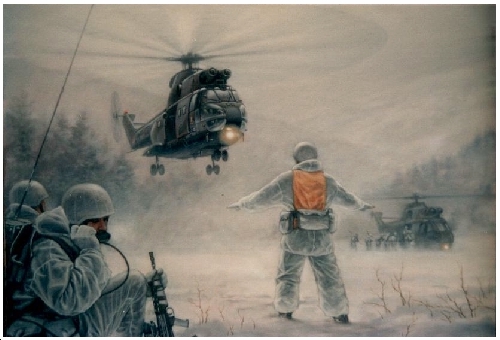|
|
|
This is the full text of an article written recently for the magazine of the Manchester Aviation Art Society, in response to yet another discussion on depicting propellers. In particular, to a suggestion that we apply thinking to the "problem". Ron ------------------------------------ Taking the Spin out of that PropWhen our editor kindly alerted me that the old chestnut of spinning props has surfaced yet again in our midst, my initial reaction was one of deja-vu and exasperation. What about all those other multitudinous aerodynamic features which move and change and deploy to keep those flying machines in the air? Flaps, slats, inlets, nozzles, ailerons, elevators, rudders, vents, blow-in doors, etc. which are so often depicted in defiance of the aerial manouevres depicted. But I go along with Andrew and Roger on their main observations on the propeller, even as a painter of mainly jet age aircraft. With helicopters, or rotating wing aircraft, the main rotor mainly generates lift rather than propulsion, as the name implies, and often goes along at only about 200 rpm( 3.3 turns/sec ), less than those bicycle-chain propellers on the original Wright Flier ( if this sounds implausible, think of those happy, freewheeling autogyros). This is way below the "flicker fusion rate" (FFR) of the human eye....the threshold at which separate images fuse..... which ranges from about 60/sec in bright light down to about 24/sec in dim light. So the "flicker" of the separate blades naturally competes with the expected visual illusion of the disc, making the helo rotor rather trickier to paint*. Also, because of their weight-bearing role, the long flexible blades describe a shallow dish rather than any flat disc or lens, especially when hovering. The key here, as with the common propeller, is to remember that due to angular velocity, the speed of the blade varies markedly across its length. So for a given engine speed, the tip of the blade is moving much faster than at the hub**. And this in fact is the major constraint on prop design, that the blade tips never approach the speed of sound, which could cause turbulence problems and overstress the prop. For that reason, it is towards the spinner that the hint of separate blades ...those notorious photographic "moustaches"....are most often visible, fading away towards the rim of the spinning prop. Watch carefully a spinning prop as the engine is cut : the blades first flicker into view next to the spinner, and then progressively materialise towards the tip of the blades as the prop slows to a halt.
Deployment to Norway (Royal Marines )
As painters, in particular painters of intricate airborne machinery, we should know that the bedrock of our art is experience. Accurate observation, and careful study of objective reality, not subjective speculation or arbitrary choice, is the final arbiter of truth. How close to that truth we may wish to go in any painting is of course a separate matter, but a correct understanding is primary, and that has to be based on observation. While thoughtfulness may be a good thing, for us SEEING the solution must be infinitely superior to second-hand deductions, inferences and expectations. Common sense tells us that thinking unhinged from reality-checks is a prolific source of humbug. A cursory reading of the history of human thought reveals its grotesque fallibility, and our own art publications have their share of overblown misconceptions. Never mind those ellipses, there's even still a Flat Earth Society out there...try Googling it. The old adage that an image( read: "experience" ) is worth ten thousand words( read: "thoughts"/"ideas") is good as ever. Should it be any surprise that LOOKING should be central for painters? I still have my younger child's battery-powered plastic P51 Mustang. Tethered to the ceiling by a metre-long fishline, a flick of a switch sends the powerful little prop spinning and the sturdy 1/32(approx) scale model whizzing gleefully around the ceiling. Protective headgear is a good idea for adults! But held in hand, the model readily offers the visual properties of the rotating prop in the comfort of your studio( yes, the 4 blades are in black, with yellow tips). Seated at my easel, I can angle the spotlight to glean the subtle optical qualities of that spinning prop from any direction I choose. Cuts out a lot of the hype and palaver. On the minority occasions when I paint those non-jets. I can recommend investing in such a model( £4.99 a few years ago) if you're overly concerned about depicting that spinning prop. Cheers Ronald Wong *The FFR blends not just physical shape but also colour. For instance, tropical butterflies and birds can display colours in flight which they do not have when immobile. But that's a different story, although I cannot help but wonder if the aircraft camouflage experts have picked up on that one. **Which is also why even for the regular smaller-diameter props, the engine operates at quite modest revs. The Spitfire's RR Merlin developes its power at 3000rpm, compared to our car engines which often go to 5000-6000rpm. |
